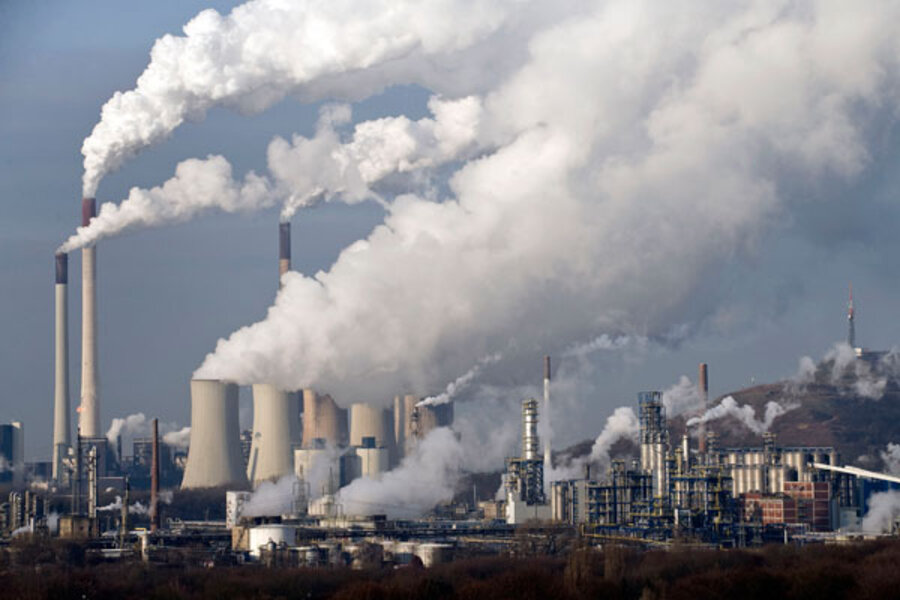Good news on global warming? Emissions going up, but more slowly.
Loading...
Despite a record-setting increase in the amount of carbon dioxide released from power plants, factories, and other human activities last year, there may have been a silver lining: emissions increased at a significantly slower rate than they have during the past 10 years on average, according to a new report.
The reduction in the rate of increase took place even as the global economy grew. This could signal that countries are using more green energy, which allows them to grow economically without similarly increasing their CO2 emissions. But other variables suggest 2013 could also be an anomaly.
The report comes on the eve of global climate talks set to take place in Warsaw Nov. 11-22. The talks are aimed at laying the groundwork for a new international agreement to combat global warming in ways that include major greenhouse-gas emitters such as China and India as well as industrial countries that historically have been the major emitters.
CO2 emissions in 2012 reached a record 34.5 billion tons, according to a preliminary estimate published Oct. 30 by the PBL Netherlands Environmental Assessment in The Hague and the European Commission's Joint Research Center in Brussels. But that represented a one-year rise of 1.4 percent, compared with an average annual increase of 2.9 percent per year since 2000. When the authors adjusted their figures to account for a leap year in 2012 the increase fell to 1.1 percent.
Either way, prior to 2012, the lowest rate of increase occurred between 2008 and 2009 when the rate of increase in emissions fell from 1.9 percent to 1.3 percent.
The rate of increase eased even though the global economy continued to grow by 3.5 percent, roughly the annual pace it has experienced during the past decade, according to the report.
One contributor: an increase in the use of energy from renewable sources. The report's authors note that the use of new sources of renewable energy doubled between 1992 and 2007 to 1.1 percent. It doubled again in less than half the time, reaching 2.4 percent in 2013, the study notes.
But other factors also were at play that had less to do with climate-motivated green-energy policies than than with economic cycles or policies aimed at softening the effects of those cycles.
The report notes that last year, the European Union was still grappling with recession. Emissions declined by 1.3 percent largely because the economy burned less oil and gas and required less electricity, while reduced production at factories reduced the demand for fuel to transport parts to factories and goods to market.
Within those broader numbers, key EU players shifted their energy mix in ways that could undercut the decline in CO2 emissions when economic conditions improve. While Poland and the Czech Republic reduced their use of coal last year by 4 and 8 percent respectively, Britain increased its coal consumption by 24 percent, with France and Spain increasing their coal consumption by comparable amounts. Germany, which has made significant progress in expanding the use of solar and wind energy, nevertheless increased its coal consumption by 4 percent as it works to phase out its nuclear power plants in the wake of last year's nuclear disaster at Fukushima, triggered by a tsunami that followed an earthquake off the coast of Japan in March 2011.
In China, with an economy that tops the charts on CO2 emissions, the government has throttled back on policies designed to stimulate the economy during the past decade – policies that led to annual growth rates that ranged from 6 to 13 percent per year, the report observes. At the same time, however, the government has moved to increase the country's use of renewable energy sources and has set increasingly strict efficiency standards. Generally, compliance has been good, but enforcement is inconsistent, note researchers from the Lawrence Berkeley National Laboratory in a new study, published on line in the December issue of the journal Energy Policy.
Meanwhile, the US continues to see declines in CO2 emissions triggered largely by the onset of the Great Recession and more recently through increased use of natural gas at power plants. That increase has come as natural gas prices have tumbled with the use of hydraulic fracturing to draw gas from underground formations once thought to be too difficult to exploit. The US has become the world's largest natural-gas producer as a result.
The report notes that the world could be seeing the beginning of a long-term slowdown in CO2 emissions growth if China meets its internal targets for energy efficiency and boosts the use of natural gas. In addition, the US would need to increase its use of natural gas and renewables, and the EU would need to improve the emissions-trading scheme it set up to comply with emissions-reduction targets in the 1997 Kyoto Protocol. The protocol's first enforcement period expired last year.
Beyond policy measures, trends in the expansion of various fuels, especially shale oil and fracking-extracted gas, and the effect of that expansion on fuel costs will also play a vital role in determining how carbon intensive the global economy becomes.
Moreover, while the rate of increase in emissions eased last year, researchers note that CO2 concentrations accumulate in the atmosphere far faster than natural processes can remove it and so accumulate at ever larger levels. To stabilize concentrations of climate-warming gases, let alone reduce the concentrations, emissions need to fall to virtually zero.






